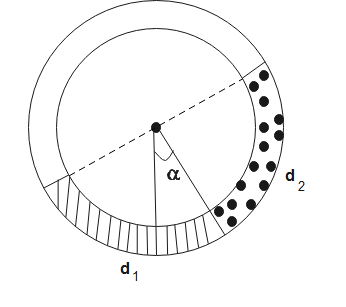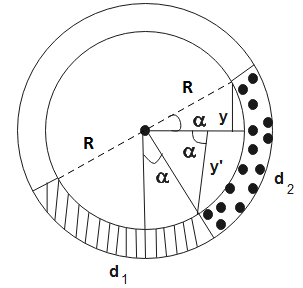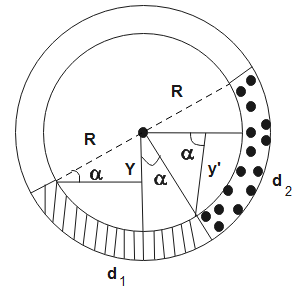Question
Question: There is a circular tube in a vertical plane. Two liquids which do not mix and are of densities \({{...
There is a circular tube in a vertical plane. Two liquids which do not mix and are of densities d1 and d2 are filled in the tube. Each liquid subtends 90o angle at the centre. Radius joining their interface makes an angle α with the vertical. Ratio of d2d1 is-
(A). 1−tanα1+tanα
(B). 1−cosα1+sinα
(C). 1−sinα1+sinα
(D). 1−cosα1+cosα

Solution
Two liquids of densities do not mix with each other and are at equilibrium at the interface. Using Bernoulli’s equation, we can calculate the pressure of each liquid. As they are at equilibrium at the interface, pressure due to both liquids will be equal and opposite.
Formulas Used:
P=Po+ρgh
Complete answer:
Given two liquids of density d1andd2 are filled in a tube and do not mix with each other. Both subtend an angle 90o at the centre.
At the interface, both liquids are at equilibrium. Therefore, the pressure due to both liquids is equal at the interface.
According to Bernoulli’s theorem, the pressure due to liquids is-
P=Po+ρgh ---- (1)
Here,P is pressure due to the liquid
Po is atmospheric pressure
ρ is density of the liquid
g is acceleration due to gravity
h is its height
For liquid-1,

From the figure, we can see that,
y=Rsinαy′=Rcosα
So the height of liquid with densityd2will be-R(sinα+cosα)
From eq (1), the pressure of liquid will be-
P2=P0+d2gR(sinα+cosα) ---- (2)

Form the above figure, we can see that,
y′=RcosαY=Rsinα
So the height of liquid with densityd1will be-R(cosα−sinα)
From eq (1), the pressure of the liquid is-
P1=P0+d1gR(cosα−sinα) ---- (3)
At the interface pressure is same, therefore equating eq (2) and eq (3), we get,
P0+d1gR(cosα−sinα)=P0+d2gR(sinα+cosα)⇒d1(cosα−sinα)=d2(sinα+cosα)⇒d2d1=cosα−sinαsinα+cosα
Dividing the above equation bycosα, we get,
∴d2d1=1−tanα1+tanα
The ratio of d2d1is1−tanα1+tanα.
Hence, the correct option is (A).
Note:
Pressure due to a fluid is the force exerted by it per unit area. A fluid enclosed in a container exerts pressure in all the directions. Bernoulli’s principle says that when the velocity of fluid increases, its potential energy decreases. Bernoulli's principle follows the law of conservation of energy, i.e. sum of all energies possessed by the flowing fluid is constant.
